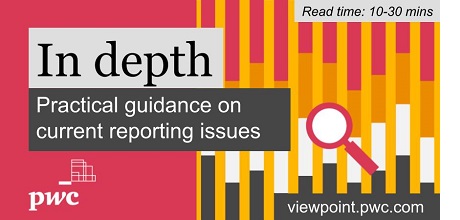Search within this section
Select a section below and enter your search term, or to search all click PwC auditing In briefs and In depths (for all users)

Favorited Content
The International Auditing and Assurance Standards Board (‘IAASB’, or the ‘Board’) has issued an Exposure Draft (ED) of the International Standard on Sustainability Assurance (‘ISSA’) 5000, General Requirements for Sustainability Assurance (hereafter ‘ED-5000’). Comments are due by 1 December 2023.
The proposed general requirements standard is the first in what is anticipated to be a new series of assurance standards: the International Standards on Sustainability Assurance (‘ISSAs’).
The general requirements standard has been developed using existing requirements and guidance from ISAE 3000 (Revised) and ISAE 3410, the IAASB’s non-authoritative guidance on Applying ISAE 3000 (Revised) to Sustainability and Other Forms of Extended External Reporting (EER) Assurance Engagements, and, to the extent deemed appropriate, certain requirements and guidance from more recently revised International Standards on Auditing (‘ISAs’).
Headline messages - Overview of key proposals
|
Sustainability matters – Environmental, social, economic and cultural matters, including:
I. the impacts of an entity’s activities, products and services on the environment, society, economy or culture, or the impacts on the entity; and
II. the entity’s policies, performance, plans, goals and governance relating to such matters.
|
Sustainability information – Information about sustainability matters. Sustainability information results from measuring or evaluating sustainability matters against the applicable criteria.
|
Disclosure(s) – Specific sustainability information related to an aspect of a topic.
|
Topics |
Aspects of Topics |
|---|---|
|
|

Criteria – The benchmarks used to measure or evaluate the sustainability matters. The ‘applicable criteria’ are the criteria used for a particular engagement and comprise either framework criteria, entity-developed criteria or both. Framework criteria are either fair presentation criteria or compliance criteria.
|
|

Engagement team – The engagement leader and other personnel performing the engagement, and any other individuals who perform procedures on the engagement, excluding a practitioner’s external expert.
|
Practitioner is able to be sufficiently and appropriately involved in the work |
Practitioner is unable to be sufficiently and appropriately involved in the work |
|
|---|---|---|
Firm personnel |
Engagement team member
Direction, Supervision & Review (DS&R) applies
(ED-5000, paragraphs 45-48)
|
N/A
|
Practitioner’s internal expert |
Engagement team member
DS&R applies
(ED-5000, paragraphs 45-48)
|
N/A
|
Practitioner’s External Expert |
Using the work of a practitioner’s external expert
(ED-5000, paragraphs 42 and 49-50)
|
N/A
|
Other Firms (including network firms and non-network firms) |
Engagement team member
DS&R applies
(ED-5000, paragraphs 42 and 51-54)
|
Using the work of another practitioner
(ED-5000, paragraphs 42 and 51-54)
|
Internal audit function |
Using the work of the internal audit function
(ED-5000, paragraph 55)
|
Using the Work of the Internal fudit function
(ED-5000, paragraph 55)
|
When an entity is required to consider both the impact of sustainability matters on the entity and the impacts of the entity on sustainability matters (‘double materiality’) when determining what to report, this does not mean that the practitioner sets two different materiality levels for a particular disclosure. |
Limited Assurance |
Reasonable Assurance |
|---|---|
Obtain an understanding of certain components (control environment, results of the entity’s risk assessment process, and the information system and communication)
(ED-5000, para 102L)
|
Obtain an understanding of all components. (ED-5000, para 102R) |
Conditional requirement to obtain an understanding of controls (and related IT general controls) if the practitioner plans to obtain evidence by testing the operating effectiveness of controls
(ED-5000, para 107L)
|
Obtain an understanding of controls for which the practitioner plans to obtain evidence by testing their operating effectiveness, related IT general controls, and other controls that the practitioner judges are necessary to test
(ED-5000, para 107R)
|
Obtain an understanding, and evaluate the design and determine the implementation, of controls that the practitioner plans to test
(ED-5000, para 108L)
|
Obtain an understanding, and evaluate the design and determine the implementation, of controls that the practitioner plans to test
(ED-5000, para 108L)
|
Based on the understanding of the components of internal control, consider whether one or more control deficiencies have been identified
(ED-5000, para 109L)
|
Based on the understanding of the components of internal control, determine whether one or more control deficiencies have been identified
(ED-5000, para 109L)
|
“Stakeholders noted that modified assurance reports on sustainability information are expected to be more common given that sustainability reporting is still maturing”
|
Questions? |
|---|
For more information, or if you have questions about the matters addressed in this In depth, please get in touch with your primary PwC engagement team contact. |
© #year# PricewaterhouseCoopers LLP. This content is copyright protected. It is for your own use only - do not redistribute. These materials were downloaded from PwC's Viewpoint (viewpoint.pwc.com) under licence.
Any trademarks included are trademarks of their respective owners and are not affiliated with, nor endorsed by, PwC. PwC refers to the PwC network and/or one or more of its member firms, each of which is a separate legal entity. Please see www.pwc.com/structure for further details.

Select a section below and enter your search term, or to search all click PwC auditing In briefs and In depths (for all users)











